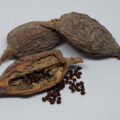Sananga is a traditional medicine of the Yawanawá tribe, an indigenous group that is known as the legal guardians of the Amazon. They have been using Sananga and other Amazonian plant medicines for generations. They use Sananga for healing both spiritual and physical ailments, which include improving their focus and clearing out distracting energies before going on a hunt.
Sananga also known as “lightning in the eyes” is an Amazonian spiritual eye drops that is brewed from the Tabernaemontana genus of Amazonian shrubsin the Amazon. It is not psychoactive, but promotes and improves the capacity of vision, (the vision becomes more accurate) extending the connection to the spiritual. Sananga corrects optical imperfections in energy level. Sananga cleans the cornea and retina, many notice better vision after use. On an energetic level, Sananga works very similarly to Rapé, cleaning the energy field and aligning the spirit on a molecular and cellular level.
Some tribes in Brazil use sananga prior to ayahuasca ceremonies because they believe it has a healing power that is more energetic than physical, increasing spiritual insight in those who use it. Many people today also use it in conjunction with kambô or other psychedelic plants and chemicals.
Among its myriad benefits, sananga is said to be capable of detoxifying the body, increasing visual perception, resetting the energetic field, and treating spiritual diseases (also known as “panema”) that spring up from negative energies in the body.
There is not a large body of existing scientific research on sananga, but the data we do have indicates that these eye drops may be capable of treating ocular diseases like glaucoma, astigmatism, and blindness. Sananga has been shown to be anti-inflammatory and effective in treating skin infections due to its antimicrobial properties. Research into other plants in the Tabernaemontana genus found that they have antifungal and antioxidant properties, which can play a role in preventing cataracts and macular degeneration.
How Long Does Sananga drop effects last on the eye?
Sananga eye drops engender an intense burning sensation that typically lasts for a few minutes. Experienced practitioners claim that the pain is an important part of the healing process. They advise breathing deeply into the discomfort in order to reap all of sananga’s benefits. Sananga is commonly used in preparation for ayahuasca ceremonies due to its cleansing properties and capacity to increase visual perception and enhance colors.
How Long Does Sananga Last In The Fridge?
Questions about herbal preparation shelf-life are common, and while shelf-life and preparation potency will vary based on several factors such as the solvent used to make the preparation, how the preparation is made, stored, and used, and time itself. The strength of this medicine can vary significantly—one batch of sananga may be far more potent than another. The eye drops will only remain fresh for a few weeks without refrigeration, but can last for several months when refrigerated.
Herbal preparations like Sananga should be stored out of direct sunlight, in a dry place free from moisture, and in a cool environment (not above 110 degrees) as light, moisture, and heat are all thought to reduce the effectiveness of the herbal properties contained in the preparation.
Refrigeration (below 40° Fahrenheit) can also help to extend the shelf life of herbal products as bacteria grow more slowly in cold environments.
How Time Affects Herbal Preparation Potency
Time affects all herbal preparations including Sananga in terms of potency and effectiveness. The more time that passes, the less potent the preparation becomes. As soon as a plant is harvested, it and its properties begin to fade. Solvents can help extract and preserve a plant’s properties for a time, but effectiveness naturally wanes as time passes.
Use Your Senses To Tell When a Sananga Has Gone Bad
In this post, we’ve tried to be conservative with our recommendations for herbal preparation shelf life. However, there is wiggle room when it comes to the shelf life of various herbal preparations. Using your five senses can help guide you as to whether something has gone bad.
Think back to how your Sananga looked, smelled, tasted, or felt when you first made it. Compare that to how it looks, smells, tastes, or feels now.
Does it look different from when you first made it? Has the color changed? Do you see cloudy matter floating in the liquid? Is there mold growing on the surface?
Does it smell different? Most freshly made Sananga preparations will have an herby scent, smelling similar to the herb itself, or a scent reflecting the solvent used.
Does it taste strange? Perhaps a little sour, fizzy, or alcoholic when it was once sweet or savory?
Does it feel different? Is it gooey or slimy feeling? Has it gone from smooth to grainy?
Using your senses can help you to guess whether a Sananga preparation is past its prime and should be remade. Remember to err on the side of caution in order to protect your eyes. SEE: Top Health Benefits of Yoga With Adriene





